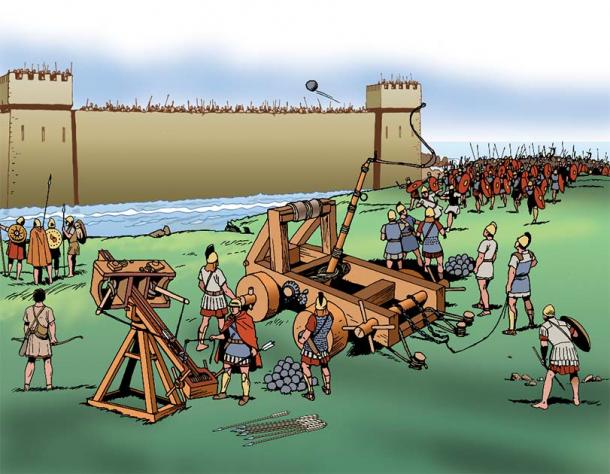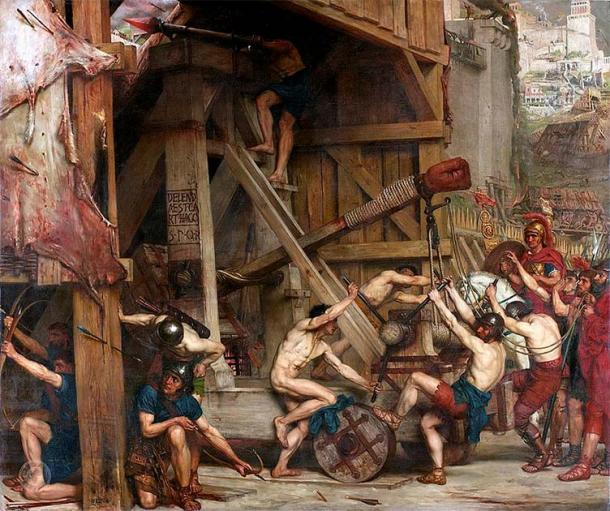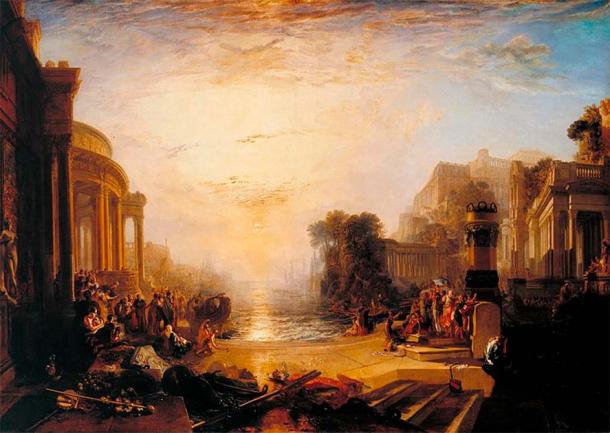
The Third Punic War: Rome's Triumph, Carthage's Tragedy
The Third Punic War might be less well known, but it was no less significant than its predecessors. The war again pitted two great powers of the Mediterranean world against each other - Rome and Carthage. For decades, the two cities had been bitter rivals, fighting over resources, trade, and territory. But in 149 BC, Rome finally saw an opportunity to rid itself of its enemy once and for all. The Third Punic War would become a brutal struggle for survival for the Carthaginians, who were forced to fight with everything they had in defense of their city. The war would ultimately lead to the complete destruction of Carthage, a catastrophic event that marked the end of an era and paved the way for Rome's dominance of the Mediterranean world.
Third Punic War - At It Again
One might wonder what possessed Carthage to enter another war with Rome. Losing the First Punic War (264-241 BC) cost Carthage its control over Sicily. Then it returned for more in 218 BC with the Second Punic War, leading to the loss of their Spanish Empire, its naval fleet, and much of its independence. So why wrestle the Roman bear a third time?
Well, if we look at coins and trade goods found across the Mediterranean it looks like Carthage actually bounced back pretty quickly from its second defeat. Evidence suggests that Carthage was even on good terms with Rome, going as far as exiling their greatest general, Hannibal, who was at the top of Rome’s hit list.
Not only were they on friendly terms, but Rome was also actually reliant on Carthage. They were a major source of Rome’s grain and barley, which meant they could actually keep up with the reparations they still owed from the Second Punic War. Carthage even lent Rome military assistance from time to time.
But this wasn’t really anything new. Before the First Punic War Rome and Carthage had gotten on just fine. Problems only arose when the two powers had begun stepping on each other's toes.
Carthage had once been a great empire and as time ticked onwards it began to resent its new position in the world order. Carthage wanted its independence back. A particular sore point was how it had lost its territory to the Numidians of northwest Africa and their leader, Masinissa.
Over time the Numidians had expanded their territory bit by bit, absorbing what had once been Carthage’s. By the mid-second century BC they had taken around half of Carthage’s territory as it had stood in 200 BC. Carthage, which wasn’t allowed to use its military without Roman permission due to the treaty agreement of the Second Punic War, could do little more than sit back and watch.
In 150 BC the Numidians attacked Oroscopa and Carthage had had enough. It responded by sending an army of 31,000 men to defend the city and attack the Numidians. It didn’t go well for Carthage. The campaign was a complete disaster and Carthage lost nearly all of its army.
The other problem was Carthage had gone to war without asking the Romans for permission. Rome could now do what it had been wanting to do since the First Punic War, finish off Carthage once and for all.
High-profile figures like Marcus Procius Cato (known as Cato the Elder) began lobbying the Roman Senate to go to war with Carthage. They pointed out that not only had Carthage gone to war without permission, but they had also done so against an important ally of Rome. The only option was to destroy Carthage, sack it, and take its booty.
For the third time, Carthage and Rome were going to war.
- Dido of Carthage, Mediterranean Princess Turned African Queen
- 2,000-Year-Old Punic-Era Tomb Accidentally Found in Malta

A map of the key locations and features in the city of Carthage around 149 BC, when the city was besieged by the Romans during the Third Punic War. (Harrias/CC BY-SA 4.0)
History Repeats Itself, Again
At the beginning of the First Punic War Carthage had had a chance to avoid war when the Romans offered peace. Back then Carthage had underestimated Rome and it cost them dearly. This time round things were different.
Carthage had finally learned its lesson. It sent envoys to Rome in an attempt to explain why they had attacked the Numidians and why they had a problem with Masinissa. Unfortunately, the Romans weren’t interested in listening.
Over the last few years, some Roman senators had been paying attention to how Carthage was bouncing back. They were concerned that Carthage was once again getting too big for its boots and had begun pushing for pre-emptive military action against Carthage. To these senators, the attack on Masinissa was the straw that broke the camel's back.
Sensing blood in the water, one of Carthage’s oldest allies, Utica (a Phoenician city in Tunisia) played turncoat and sided with the Romans. It was a harbor city just one day’s sailing away from Carthage. It was the perfect place to launch an invasion force against Carthage. This turn of events convinced the more cautious Roman senators that an attack on Carthage was a clever idea.
Not wanting to show their hand until preparations were ready, in 149 BC the Romans asked for 300 Carthaginian noble children as hostages. This was purely a sham to make Carthage think the Romans were considering letting their earlier faux pas slide. Just as Carthage let its guard down the Romans declared war and sent an army of around 80,000 infantry and 4,000 cavalry to North Africa, ready to attack Carthage.
The Romans, quite rightly, were feeling confident. In another case of deja vu from the First Punic War, they demanded that Carthage surrender. The difference was that in the First Punic War, the Romans had only wanted Carthage to leave Sicily, this time they wanted unconditional surrender.
Carthage would have to disband its army, surrender all of its weapons and release all of its prisoners. The Carthaginians then had to leave the city of Carthage completely and resettle somewhere else at least 16 km (10 miles) away from the coast.
Unsurprisingly, the Carthaginians were unmoved by the Romans’ not-so-generous offer of peace. Knowing they really had nothing to lose, they decided to go down swinging. The Carthaginians released their slaves from the city (fewer mouths to feed and less chance of a slave uprising mid-siege) and recalled a 30,000-strong Carthaginian army that was currently twiddling its thumbs at the Numidian border.
Carthage and its 200,000-strong population began preparations for a siege. Little did they know it would last three years.

Roman soldiers attack the walls of Carthage. (Massimo Todaro/Adobe Stock)
Enemy at the Gates
The Roman siege of Carthage was initially led by Marcius Censorinus and Manius Manilius. It got off to a poor start. The Romans had once again underestimated their old enemy. The senate had believed that Carthage would either surrender quickly or fall to the might of Rome.
But Carthage’s massive fortifications easily resisted the Roman siege. The city had over 34 kilometers (21 miles) of well-built defensive walls. Some areas were built in a triple defensive line (meaning there were three lines of walls to get through) while other areas had defensive structures such as palisades, ditches, and the sea to protect them.
In a siege, if you can’t destroy the enemies’ defenses the next best option is to completely cut off their supply lines and simply wait them out. The problem was that the Romans hadn’t managed to blockade Carthage’s port, meaning merchant vessels could get in and resupply the city. It was a stalemate.
The idea that the Carthaginians would simply give up also proved to be wrong. They still had some fight left in them. The Carthaginians kept sending out sorties to counterattack. Carthage had always been a naval power and they repeatedly released fire ships that caused heavy damage to the Roman fleet (making a blockade even harder).
Their counterattacks on land were just as effective. In one raid they managed to destroy many of the Roman siege engines. As the siege began to drag on an epidemic hit the Roman army during the sweltering summer of 148 BC, severely weakening it.
It turned out it wasn’t just the capital city that was happy to put up a fight. The rest of the Carthaginian army was resisting the Roman army in the countryside. When the Romans, led by consul Piso, attacked the city of Hippacra, the city refused to surrender.
The Romans were aware that history was beginning to repeat itself. The first two Punic Wars had been meant to be over quickly but had dragged on for years. The Third Punic War was shaping up to be the same.
Scipio Aemilianus Steps In
If the Romans were going to bring this war to a swift end more drastic measures were needed. In 147 BC a young, talented, and incredibly ambitious consul called Publius Cornelius Scipio Aemilianus was brought in to put an end to the fighting.
This Scipio was a force to be reckoned with. At just 36 years old Scipio Aemilianus was technically too young to be a consul (the law stated the minimum age was 41). Yet the young man had friends in powerful places and a lot of fans in the Roman public. Through clever political maneuvering and by whipping up public demand, Scipio convinced the Senate to waive the rules and allow him to become consul at 36.
He alone was given charge of the war against Carthage whereas normally each theater of war was assigned two consuls. As consul, he was granted permission to conscript as many men as he needed for the war effort but was also allowed to enroll volunteers, which was unusual.
Scipio quickly got to work building a new and improved siege wall around Carthage and its harbor. In particular, he focused on building a mole on the city’s south side. This was a massive structure made of stone that functioned as a kind of pier/ causeway. It blocked the only access point to Carthage’s harbor.
Scipio had succeeded in doing what his predecessors had failed to, cutting off Carthage’s supply lines. The Carthaginians responded by making a new exit to the harbor and attempting to sail a small fleet through it. The Romans were ready and waiting, however, and twice the Carthaginian fleet was forced to retreat back into the city.
Scipio then turned his attention to attacking the walls near Carthage’s harbor. His new mole not only blocked off the city’s access to the water, but it also acted as a handy base for Roman attacks on the harbor walls. The Carthaginians repeatedly counter-attacked and did manage to burn a few more Roman siege engines, but the stalemate was breaking.
The city was completely cut-off. This allowed Scipio to turn his attention to the Carthaginian army, which was stuck at Nepheris, 15 kilometers, (10 mi) to the south of Carthage.
In the winter of 147/146 BC, Scipio made the bold move of leaving Carthage to go and attack the army at Nepheris in a 3-week siege.

The Catapult. This shows Roman soldiers manning a siege engine for an attack on the walls of Carthage, during the siege which ended in the destruction of Carthage in 146 BC. (Public Domain)
Carthage Falls for Good
It was the right move. Scipio and his men easily defeated the Carthaginian army at Nepheris. Those Carthaginian soldiers who managed to flee were picked off by Rome’s mounted Numidian allies, who had come to join the fun. Seeing what had happened to Nepheris, most of Carthage’s remaining fortified positions opened up their gates to the enemy and surrendered.
In the spring of 146 BC, Scipio once again turned his attention to Carthage, which was still completely cut off. Scipio’s attacks on the harbor walls had proven effective and the Romans finally managed to break through them, allowing their army to slowly advance through the city.
Surprisingly, Scipio’s attack didn’t go as smoothly as the rest of his siege. The usually well-disciplined legionaries embarrassed themselves by wasting time looting the city. What should have been over quickly took seven days of brutal street-to-street skirmishing. Some Roman troops even deserted completely and joined the Carthaginian commander, Hasdrubal, in the citadel.
The final part of Carthage to fall was the temple of Eshmun, where Hasdrubal, his few remaining men, and 900 Roman deserters put up one last fight. Hasdrubal knew to expect no mercy. Earlier in the battle he had tortured Roman prisoners on the battlements in an attempt to boost Carthaginian morale.
As the Roman army approached Hasdrubal surrendered, promised by the Romans, they would let him live and retire to an Italian estate. His wife was so ashamed that she threw herself and their children onto a funeral pyre. The last few remaining soldiers followed her, having decided burning to death was better than being tortured by the Romans.
Carthage No More
Scipio had done it; Carthage had fallen for good. But Rome wasn’t done with its old enemy, not by a long shot. What was left of Carthage’s once 200,000-strong population (around 50,000) was enslaved.
Scipio was then commanded by the senate to completely demolish the city and leave nothing standing. The Romans went as far as placing a curse on anyone who might try to rebuild the city. The Romans were determined that Carthage would not rise from the ashes of defeat again. There were to be no more Punic Wars.

Painting: The Decline of the Carthaginian Empire, 1817. (Public Domain)
Carthage’s North African territories were then made a Roman province. African cities that had been loyal to Rome during the war, like Utica, were rewarded with freedom from tax. Any cities which had allied themselves to Carthage were either completely destroyed or declared ager publicus, public land.
As was usual for the Romans, they governed the surviving cities with a somewhat hands-off approach. They left Punic culture, language, and religion alone and largely left the local people to their own devices as long as they paid their taxes.
Scipio was officially a Roman hero. He was given the title of Africanus and became known as Cornelius Scipio Aemilianus Africanus the Younger, the same title his grandfather had earned in the Second Punic War. He was also awarded a triumph in Rome, one of the power’s highest honors.
- A History of Hamilcar: The Legend of Cardosa and a Lost Carthaginian City – Part I
- Hannibal of Carthage: Military Commander and Greatest Enemy of Rome
Conclusion
The Third Punic War proved to be the final Punic War. Rome had finally succeeded in defeating its old enemy. Punic culture, however, lived on though and its language was spoken in North Africa until the 7th century AD.
Carthage itself remained abandoned for a century until Julius Caesar announced he planned to rebuild it as a Roman city. He was killed before work could really get underway but his successor, Augustus renewed the work in 29 BC. By the time of the Roman Empire, Roman Carthage was one of the biggest and most prosperous cities in Roman Africa.
The war was a brutal and devastating conflict that saw the complete destruction of a once-great city, but it also represented a turning point in the evolution of warfare and diplomacy. The lessons learned from the Third Punic War would shape the way nations approached conflict for centuries to come.
Top image: Carthaginian relentless spirit, defeated in the end by the Roman Empire. Source: Julien/Adobe Stock
References
Bagnall. N. 2005. The Punic Wars. Thomas Dunne Books.
Cartwright. M. 2016. Third Punic War. Available at: https://www.worldhistory.org/Third_Punic_War/
Editors. 2023. Punic Wars. Available at: https://www.britannica.com/event/Punic-Wars
Miles. R. 2016. Carthage Must Be Destroyed. Penguin.















